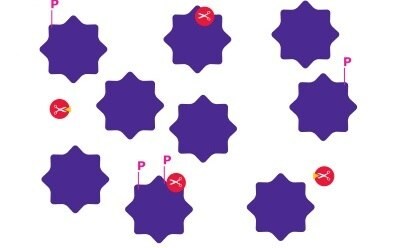Interrogation of Protein Pathways

Biochemical and environmental signals in the body control intracellular processes as well as interactions between cells, tissues, and organs. These signals are relayed by a complex network or pathway of proteins, enzymes, and receptors. Protein pathway analysis is key to understanding cellular and biological processes and their impacts on physiology, dysfunction, and disease. Small-molecule compounds, including inhibitors, activators, and other pathway modulators, are critical tools for researchers studying cell signaling and other mechanisms that control cell fate, function, and phenotype.
Explore more about the interrogation of protein pathways below.
Related Technical Articles
- Discover Bioactive Small Molecules for ADME/Tox
- Explore compound library screening options with our Pharmacologically Active Compounds portfolio.
- The C-terminal c-Src kinase (Csk) is a 50-kDa cytosolic tyrosine kinase expressed in all examined cell types
- The focal adhesion kinase (FAK) is a cytoplasmic protein tyrosine kinase. FAK has been implicated as a downstream signaling molecule that functions in the control of several integrin-regulated biological processes.
- G protein-coupled receptor kinases (GRKs) are a family of protein kinases. Learn about GRKs and why the seven GRKs can be divided into three subfamilies based on overall structural organization and homology.
- See All (14)
Related Protocols
- The appearance of uric acid is measured at 293nm by spectrophotometry.
- To measure 5′-nucleotidase activity, this procedure uses adenosine 5’-monophosphate and a color reagent to create a standard curve for determining the micromoles of phosphorus liberated.
- This procedure may be used for the determination of Amyloglucosidase activity using starch as the substrate.
- Measure luciferase activity using a luminometer assay detecting light emission, with applications in ATP detection and genetic function reporting.
- Demonstrating the effective use of Amicon Stirred Cell for large volume concentration through diafiltration.
- See All (13)
Find More Articles and Protocols
Chemical Screening and Treatment
Chemical screening is essential to drug discovery and involves identifying chemical probes. It uses techniques ranging from high-throughput screening to assaying enzyme and protein targets for potential therapeutics. An emerging trend in screening is the increased use of phenotypic assays to identify compounds that produce desired changes in biomarker expression, protein activity, and cell behavior. Chemical library screening helps researchers identify hits that can be starting points for drug discovery. From there, they can refine the hits from target-based or phenotypic screens to generate lead compounds for further investigation and development into drugs.
Protein and Enzyme Activity
Proteins are biomolecules and macromolecules that are made of amino acids. They perform varied functions in cells and organisms including:
- Catalyzing reactions
- Assisting in DNA replication
- Transporting molecules
- Providing structure to cells
- Acting as receptors for cell signaling
- Providing channels for charged molecules to pass through membranes
Investigating protein and enzyme activity is fundamental to understanding how cells and organisms function, as dysregulation of protein activity is linked to many diseases. Their activity can be probed using small molecules to disrupt or modulate function and observing changes in protein or enzyme concentration, or even through using enzyme activity assays to determine how compounds affect enzyme activity.
Protein Pathway Modulation
Protein pathway interactions play important roles in biological processes such as cell growth, differentiation, signal transduction, and apoptosis. Small molecules are important tools for probing mechanisms underlying biological processes and how they relate to disease. They also allow for the modulation of proteins involved in a pathway to identify what roles they play and how they interact with other proteins in the pathway. These pathways can be modulated by inhibition or disrupting interactions, and also by activating proteins and receptors to produce a biological response with activators or agonists.
To continue reading please sign in or create an account.
Don't Have An Account?